
The passing of Cyril Tooze, an 86-year-old from the Adelaide Hills, has brought attention to Australia’s aged care system and its impact on elderly Australians waiting for essential support.
Cyril’s decision to pursue Voluntary Assisted Dying (VAD) came after months of waiting for in-home care, which he had been approved for but never received. His story sheds light on the challenges faced by many older Australians caught in delays and backlogs, waiting for the critical assistance they need to remain safe and comfortable at home.
Earlier this year, Cyril was granted a Level 4 Home Care Package—the highest level of care available under MyAgedCare, designed for individuals with complex needs.
However, due to high demand and staffing shortages, his wait for care stretched from an initial nine months into October. Meanwhile, Cyril, who had terminal heart and lung conditions, experienced a decline in his health.
With no close family nearby, he found himself alone in navigating the aged care system while managing the physical toll of his illnesses.
A fall at home led to hospitalisation, and Cyril’s health continued to worsen. Facing a wait with no clear end, he ultimately chose VAD, a legal option in South Australia for individuals with advanced, incurable conditions.
His passing brings attention to the challenges and emotional toll experienced by many elderly Australians waiting for care.
Federal MP Rebekha Sharkie, who advocated for Cyril, reflected on his strength. “To the very end, he wanted his situation to shed light and provide a human story for the 76,000 other older Australians who, just like him, are deteriorating, having accidents and injuring themselves while waiting for a Home Care package that they’ve been assessed as needing,” she said.
Sharkie’s comments point to a larger issue within the aged care system, where thousands are waiting for services that have already been assessed as critical to their well-being.
Aged Care Minister Anika Wells extended her condolences to Cyril’s family, underscoring the importance of stories like his in driving aged care reform.
“Our reforms include a $4.3bn investment in the new Support at Home program that will benefit around 1.4 million Australians by 2035,” she said. “That program is designed specifically to help older Australians remain independent, in their home and their community for longer.”
The program aims to reduce waiting times and increase access to tailored support, marking an ambitious step toward addressing the needs of the growing elderly population.
While these reforms offer a pathway to improvements, they also highlight the current pressures on Australia’s aged care system. Staffing shortages, rising demand, and the sheer scale of the waiting list show that more immediate action may be required to support those in need right now.
How in all consciene can anyone call this aged ‘care’.
It is up to people and tge media to change the language. Govt and ibdustry looove the fake, gaslighting terms they feed to us. It is up to us to change the language from that rubbish rhetoric to accurate words
If we don’t change all avenues that might enable change that benefits the aged will remain cut off.
The Minister may well express condolances…..but where was she when her intervention could have helped this man. I am sooooooo very very tired of her rhetoric around how things will change. She has had time to ensure that this sort of horror and similar, are not happening now …. right on her watch. We,the consumers, are aware of the future with the new act and it looks bleak with just as much liklihood of more situations like this occurring. Consumers are not favoured by the new Bill …one hour of cleaning a week for someone like this man and 18 hours of gardening per year. I sincerely wish I had never spent the majority of 40 years in health care and I might be in better condition to do everything I need now and into my future We are the age group without the super, without after hour and holiday child care. My school holiday wages went into paying someone for that child care ….along with care after school when I was trying to sleep after night shifts
Shame on the Labor Govt for thinking that all this rhetoric is what we need or want. I worked and voted for Labor for 60 years. I cannot vote for the alternate, so i will never vote again.
I am simply horrorified at this dreadful story, the agony in this mans brain and body before he did what many may well need to choose in future. We attempt to treat most animals better than this slow lingering suffering endured by this man.
Please get your act together Minister Wells or get out and let somone less self satisfied and non caring and with more involvment in the aged, fill the position. Your background in legal studies does not fit you for this portfolio. I cannot imagine what it will be like come the Olympics when you will be there full time no doubt.What made Albanese choose you is the question that confuses many many …including myself.. It makes me doubt his judgment across the board and that for me, is a sadness I did not expect.